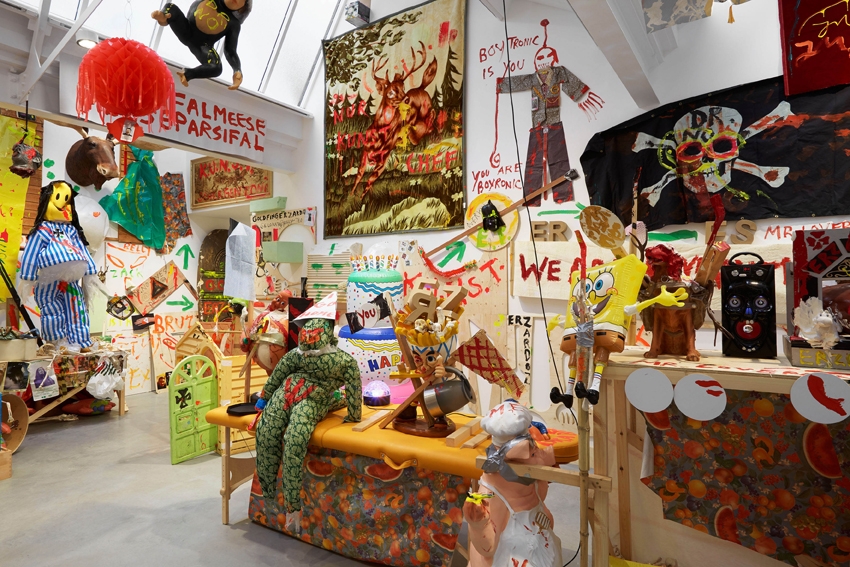Samuel Beckett had a thought or two about the artist’s social role back in 1961. ‘To find a form that accommodates the mess, that is the task of the artist now,’ he said. If an encounter with Jonathan Meese’s blizzard of pop memorabilia (piled high enough to provoke a sensation of claustrophobia, with a path weaving through it all) is anything to go by, Beckett was right on the money: for such encounters are a familiar experience to the seasoned gallery-goer in 2015.
Not just because this kind of ramshackle pile of stuff is a recognisable motif in art right now – think installations by Thomas Hirschhorn, Song Dong or Christoph Büchel – but also because of the increasing torrent of visual information that has come to characterise living under capitalism (something upon which these artists, to generalise, are reflecting). Take a minute in Modern Art and take in the beach towels emblazoned with animals, the inflatable monkeys, aliens, birthday cakes and SpongeBobs, fibreglass hotdogs wearing manic grins, Wendy houses, mounted moose heads, rocking horses, Bruce Lee figurines, mannequins. Put up no defence as they cascade past your eyes. See Meese’s more autobiographical references: a banner scrawled with the slogan, ‘We are Bayreuth’ (the Bavarian city that hosts the annual opera festival that cancelled Meese’s direction of Wagner’s Parsifal, 1882, citing budget reasons, not long after the artist was unsuccessfully, and independently of the Bayreuth episode, prosecuted in 2013 for making a Nazi salute onstage at Kassel University). And the more controversial references: ‘ISIS Love’ reads another, written on a large aluminium-foil sign in the shape of the Iron Cross. Wall-hung paintings, equally messy and anarchic, surround the installation. Highly worked thick washes of paint clash with each other, occasional forms emerging from among the abstraction – weird mismade figures; a heraldic lion; a bicycle; scrawled phrases. In the separate viewing room are more paintings of a similar ilk – only some of these have toy farm-animals trapped, encased, in the mire of thick paint.
Meese’s contrarianism has a point to it. By mixing the shocking and the innocuous, he undermines the ideology that gives the former its visceral power. It’s hard to take a proclamation of the Islamic State seriously when overlooked by a dumb-faced poodle with its tongue lolling. So while he is similarly giving form to the mess of visual information that we wade through every day, Meese, unlike Hirschhorn et al, boils these symbols and motifs down to their formalist qualities, flattening the political or historical hierarchies to the point of absurdity. In doing so he takes on the role of the jester, extravagantly undermining society and its ideologies through mimicry. The fool who has no desire to offer answers but slyly serves the court through mockery.
This article was first published in the March 2015 issue.
